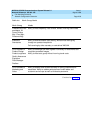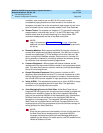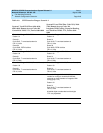
MERLIN LEGEND Communications System Release 6.1
Network Reference
555-661-150
Issue 1
August 1998
Call-Handling Scenarios
Page 2-41Network Configuration Scenarios
2
Other system equipment includes Uninterruptible Power Supplies (UPSs) to
supply backup power in the event of a commercial power failure.
People in both locations use these features:
■ Covering Calls. In workgroups and in the executive suite, calls are
covered using SSA buttons, call coverage features (Cover buttons and
coverage to the centralized VMS/AA), Call Forwarding, and Group Pickup.
■ Security. Authorization Codes allow executives to call from any extension
using their own privileges. ARS restrictions limit toll-calling privileges for
many extensions. The system manager applies most restrictions at the
extension level. Temporary calling group agents do not need to make
intersystem calls and are prevented from doing so or from making toll calls.
For Release 3.1 or later systems, voice mail ports are factory set with an
FRL of 0, prohibiting outcalling.
SECURITYlALERT:
!
For more information about security, consult “Security of Your
System: Preventing Toll Fraud,” in Appendix A, “Customer Support
Information” and Chapter 4, “Security.”
■ Speed Dialing. Personal and System Speed dial codes and directories
help people quickly reach frequently called numbers. Some staff members
also use Auto Dial buttons. PassageWay Telephony Services clients use
power-dialing applications for rapid outcalling to customers. On each
system, the System Directory includes entries for non-local extensions.
SECURITYlALERT:
!
Never program passwords and/or authorization codes as Speed Dial
codes.
Both features and equipment fill paging needs. A loudspeaker paging system
connected to the control unit in the West coast office allows the receptionist to
page people working in noisy areas such as the factory. The system’s Group
Paging feature serves the same purpose for people in offices.
Work Groups 2
The following work groups use specialized equipment, features, and applications
that serve their needs:
■ Executive Managers. Each location includes a conference room with a
group videoconferencing system that allows face-to-face meetings. The
systems use one MLX port each (programmed for 2B data). Video
extensions use both tandem T1 tie trunks programmed for data to
communicate with the extensions on the other system and PSTN digital
facilities for meetings with key corporate customers.


















